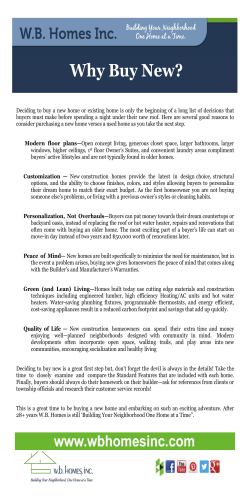
Well Connected - Hartford Steam Boiler
Property/Casualty Underwriting By Rebecca Galovich C onnected homes have almost unlimited possibilities. Already, smartphones enable homeowners to set their thermostats, start a load of laundry or get an alert when the garage door is open, and to close it remotely from anywhere they have a network connection. At home, a single communications hub and phone app allow families to control lighting, appliances, entertainment, security and a host of other functions. Smart sensors will even remind you when you are running out of milk or need to buy eggs. The novelty of connected homes is often played up in the news. The Well Connected Insight: The day is fast approaching when clients will be talking to their homes. Homeowners insurance may soon be available from nontraditional sources. real story, however, is about what’s yet to come. Technology and energy trends are changing the way people live in their homes and how companies are doing business. The concept of a “whole home monitoring system” is based on the interconnectivity of smartphones, home systems and computers. In addition to lights, windows and appliances, connected equipment will include smart electric meters, plugs, heating and cooling. Today’s patch quilt of mobile apps and add-on sensors will evolve into new homes built with technology at the core, connecting every device and piece of equipment to each other and the Internet. Once technology standards are in place that enable all devices and equipment to communicate: • Home equipment will interconnect and be able to adapt to the behavior of the occupants. • Smart appliances will become Best’s Review contributor Rebecca Galovich is vice president for personal lines underwriting and product management at Hartford Steam Boiler. She can be reached at [email protected] 64 BEST’S REVIEW www.bestreview.com February 2015 mainstream, communicating and working together for optimal energy use, water efficiency and cost savings. • Electric vehicles will charge at home and longer-term home power generation will become prevalent. • An aging population will stay in their homes longer as more medical technologies enable people to be monitored, diagnosed and even treated remotely. What does this mean for agents and insurers? Home connectivity will help reduce losses from fire, wind and water damage. Home sensors and smart software could have a significant, positive impact on underwriting profits. With a connected home, water leaks can be detected and remotely shut off at the source. Smart fire alarms will sense smoke or carbon dioxide and automatically contact emergency response centers. Video cameras can monitor the property. We will see more insurance companies offering discounts on premium and on the purchase of smart equipment and devices.That, in turn, will help convince more people to purchase and upgrade their connected home devices. Connected homes also bring new exposures. Sensors, alarms, controls and communication systems add complexity to home equipment and make it important to include home systems breakdown coverage in homeowners policies. Utility interruptions of electrical power or broadband service would be devastating and also create demand for an insurance solution. There will be new personal cyber, cloud and data exposures through external third-party connections and the need for identity protection. The race toward home connectivity is on, but the market has not yet determined the winners in this space. Insurers, agents and brokers must prepare now for the big changes that are coming to the homeowners insurance market. BR BEST’S REVIEW • FEBRUARY 2015 Copyright © 2015 by A.M. Best Company, Inc. All Rights Reserved. Reprinted with Permission. www.ambest.com
© Copyright 2026





















